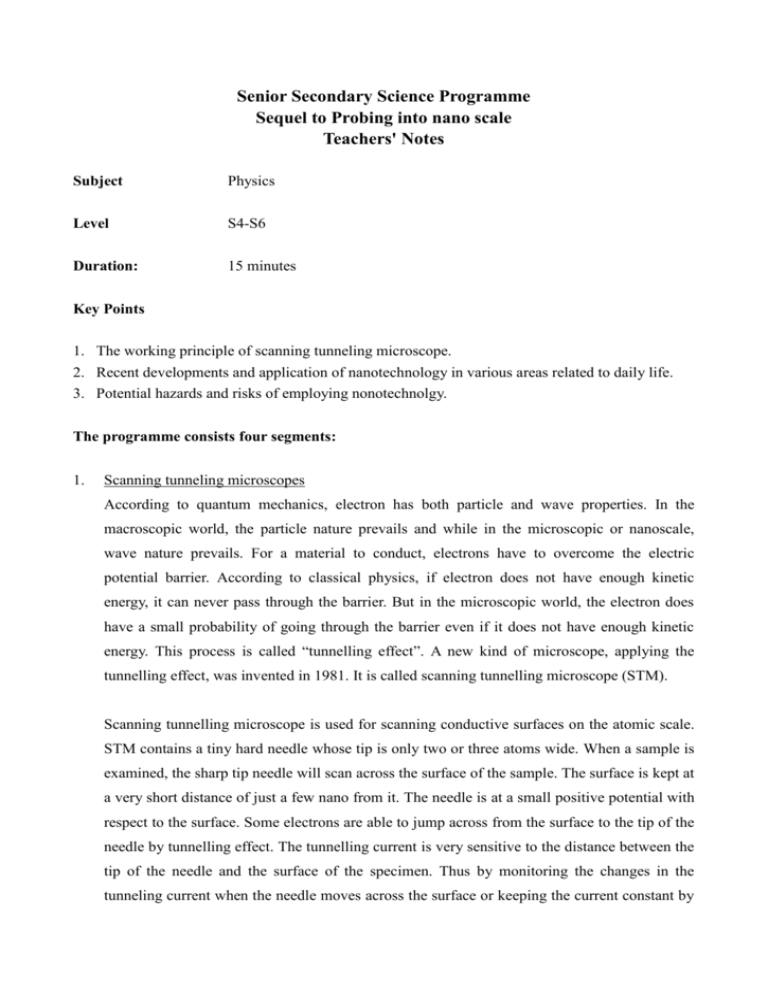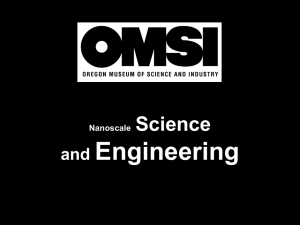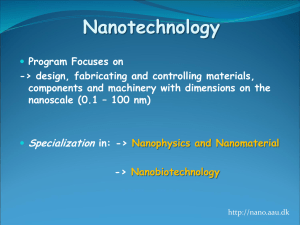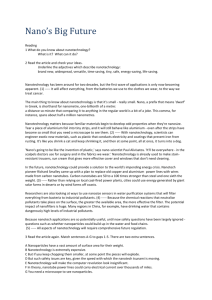Senior Science topics Programme
advertisement

Senior Secondary Science Programme Sequel to Probing into nano scale Teachers' Notes Subject Physics Level S4-S6 Duration: 15 minutes Key Points 1. The working principle of scanning tunneling microscope. 2. Recent developments and application of nanotechnology in various areas related to daily life. 3. Potential hazards and risks of employing nonotechnolgy. The programme consists four segments: 1. Scanning tunneling microscopes According to quantum mechanics, electron has both particle and wave properties. In the macroscopic world, the particle nature prevails and while in the microscopic or nanoscale, wave nature prevails. For a material to conduct, electrons have to overcome the electric potential barrier. According to classical physics, if electron does not have enough kinetic energy, it can never pass through the barrier. But in the microscopic world, the electron does have a small probability of going through the barrier even if it does not have enough kinetic energy. This process is called “tunnelling effect”. A new kind of microscope, applying the tunnelling effect, was invented in 1981. It is called scanning tunnelling microscope (STM). Scanning tunnelling microscope is used for scanning conductive surfaces on the atomic scale. STM contains a tiny hard needle whose tip is only two or three atoms wide. When a sample is examined, the sharp tip needle will scan across the surface of the sample. The surface is kept at a very short distance of just a few nano from it. The needle is at a small positive potential with respect to the surface. Some electrons are able to jump across from the surface to the tip of the needle by tunnelling effect. The tunnelling current is very sensitive to the distance between the tip of the needle and the surface of the specimen. Thus by monitoring the changes in the tunneling current when the needle moves across the surface or keeping the current constant by varying the height of the needle, the computer can use the data to construct a magnified three-dimensional image of the surface. 2. Nanotechnology in Nature Phenomenon raised from nanoscale already exists in nature. Nanoparticles can be discovered in the environment and found among living thing and non-living things. Lotuses usually grow in muddy pond, but their leaves can remain clean and dry. When we look at the lotus leafs in detail, we’ll find that the water on the leaf does not spread. Instead water will form drop on the surface of the leaf. These drops move easily across the surface of the leaf and take away the dust and dirt to achieve automatic cleaning. This is called “lotus effect”. The lotus effect is actually related to nano phenomenon. Under a high resolution electronic microscope, there are small micron-size bumps on the surface of the lotus leaf which are coated with fine wax nanocrystals. The waxy materials are hydrophobic. Water on the hydrophobic surface will form water drops and not making the surface wet. Bumps on a flat hydrophobic surface will turn it into a super-hydrophobic surface. The contact size of water and surface is small because of the bumpy and small surface, the water drops will become rounded and roll easily on the leaf. In addition, due to the bumpy surface of the leaf, the particles of the dirt can only stay on the bumpy surface instead of penetrating it. When the water drops roll on the leaf surface, they can wash away the dirty particles to achieve the automatic cleaning effect. Scientists have already tried simulating the lotus effect to our daily applications. For example, special nanocoatings or nanopaint can be added to tiles and paints to keep the surface of the house or buildings clean and dry; added to leather, clothes and raincoats to improve their water-proof and antifouling functions. Some butterflies’ wing scales, like those of the Paris Peacock, has beautiful colors. The interested thing is that the colors vary with viewing angles. There are photonic crystals on the butterfly wings. Photonic crystals are periodic optical nanostructures. The structure can operate like grating system to produce various colors. For example, there are thousands scales on the wing of the Paris Peacock. Each scale is scattered with long sharp ridge-like structure. The bottom of the structure is a multilayer branch-like cuticle, like a big piece of Christmas tree. The distance between each branch is around 100 nano, and the multilayer Christmas tree liked structure produced the same effect similar to photonic crystal. It is responsible for the different colour in the wings of the beautiful butterfly. Pigeons, bees, birds and turtles have the ability to identify direction so they can fly or dive for long distance without getting lose the way. It is because there have nanostructures inside their bodies. These nanostructures are magnetic in property. When they are under the influence of Earth’s magnetic field, the magnetic nanoparticles will give navigating function to enable the living creatures to identify directions. Although Van der Waals’ force is a weak force, there are millions of fine hairs each with a diameter of a few hundred nano on the feet of a lizard. When millions of nanoscale fine hairs work together, it will produce a very strong attractive force to support the weight of a lizard. 3. Nanotechnology in daily lives Nano substances already exist in nature for a long time, but humans have in fact unknowingly used them in our daily life. Medieval artisans knew that they could produce stained glass of different colors by adding different metal oxides to the molten glass. Stained glass is a kind of western architectural decorations, usually found on the wall of the church. Stained glass can also be seen in the Islamic mosques. It can cause dazzling effect when sunlight shines on the glass. At night time, the colorful lights made by lighting created various colors. This effect is caused by the nanoparticles produced in the mixing process. It was these nanoparticles that gave the glass distinctive colors. Nanotechnology can be applied to building materials like tiles, glasses and paints to make it with self-cleaning and anti-fouling function. The common self-cleaning tiles and glass can be divided into two types. One of these is applying the lotus effect. The coating on the surface of glass or tiles is nanoparticles which are hydrophobic. Droplets of water are formed on the surface when rain falls on it. The droplets roll easily carrying away the dirt to achieve the purpose of self-cleaning. Another type of self-cleaning tiles and glasses is using photocatalyst on the surface. As the advancement of nanotechnology, some nanomaterials can accelerate chemical reaction in the presence of light without themselves being changed. They are called photocatalysts. Two common photocatalysts are titanium dioxide and zinc oxide nanoparticles. When titanium dioxide nanoparticles are used as coating on a glass surface with Sun shining on it, water falls on the surface will become hydrophilic and will spread evenly on it forming a thin film rather than droplets. Dirt attached in the film of water can easily be removed as the film of water slides down during raining. In addition, when photocatalyst are exposed to sunlight, free radicals are produced. These radicals can break down the organic dirt to produce self-cleaning, sterilize and deodorant effect. 4. Nanotechnology and the future Nanotechnology has developed rapidly. The products have various applications, like carbon nanotube, nano battery, nano building materials, nano filter membrane, smart windows and ultra-thin display, etc. On the one hand, nanotechnology has raised safety and environmental concerns. Because of the high ratio of surface area to volume of nano particles, they have a very high chemical activity and may cause unexpected reaction to human bodies. On the other hand, the functional cells of human body have a size much larger than nano. Therefore, nanoparticles or fiber can enter the human body through respiratory system, blood and skin, or even penetrate into the genes through cell membrane. This will cause genetic changes. In addition, nanoparticles are very active. If they leak out accidentally, they will spread by winds and water and lead to uncontrollable nano pollution If nanotechnology continues advancing, the prevailing perception and moral concept of human beings will be challenged. Try to imagine, when nano materials become popular, undoubtedly it will replace most of the materials we use today because it’s lighter, thinner, more supreme, more durable and more functional. A display thinner than a sheet of paper; a computer that can fold and put in the pocket; implanted navigation system; implanted nano detector; nano spaceship that flies everywhere. The development of Nanotechnology is unavoidable. The urgent issue is how to live with it and to set up a safety standards. Suggested Learning Activities Preparation before viewing the programme 1. Teacher may discuss with students how nanotechnology is involved in daily life Activities after viewing the programme 1. 2. Student may, under the guidance of teacher, review the physical concepts presented in the programme. The teacher may discuss with students the impact and hazard when nanotechnology becomes parts of our life.






